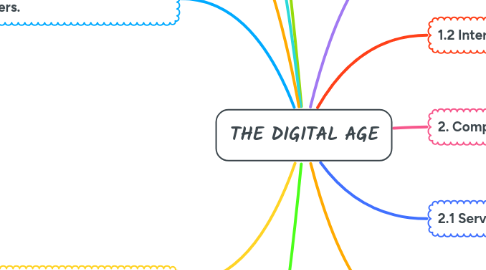
1. 2.3.1 Layered model.
1.1. Each device on the network has these layers (modules).
1.1.1. The TCP / IP layers are: Application layer, Transport layer, Internet layer and Network acces layer.
2. 2.3.2 Datagrams.
2.1. The data at the time of transmission is encapsulated in packets or datagrams.
2.1.1. Each package has two parts: Header and Data.
2.1.1.1. A datagram resembles a letter, the header would be the destination and the sender, and the data would be the letter that the envelope contains.
3. 2.3.3 Protocols TCP / IP.
3.1. TPC / IP is composed of a series of protocols.
3.1.1. The most used are: HTTP (HyperText Transfer Protocol), SMTP (Simple Mail Transfer Protocol), POP3 (Post Office Protocol),FTP (File Transfer Protocol).
4. 2.3.3.1 System Binary. Range of integers.
4.1. Formula to know the range of integers as a function of number of bits (digits, figures).
4.1.1. B ^ n: B = base of the number system (in binary system 2). n = width of digits.
5. 2.3.4.3 Versions of the IP Protocol.
5.1. IPv4:Since 1981 Implemented in most connected devices 32-bit addresses 2 ^ 32 addresses (devices) Addresses made up of 4 numbers from 0 to 255 separated by points. Ex. 84.123.133.45 XXX0 network address XXX1 router (usually) XXX255 Broadcast 127.0.0.1 Loopback
5.2. IPv6:128-bit addresses 2 ^ 128 addresses (devices) Addresses made up of 8 number groups of 4 digits in hexadecimal separated by a colon (:) Equipment autoconfiguration Security and encryption mechanisms Better performance Offers mobility between different networks without losing connection
6. 2.3.4.3 Addresses Public and private IP.
6.1. All connected equipment directly to the Internet have a public IP address.
6.1.1. Public addresses are unique (no other computer on the Internet can have the same public IP although there is an exception)
6.1.2. New node
6.1.2.1. Private addresses are used in private networks (not accessible from the Internet).
6.1.2.1.1. The computers in a private network share the public address of the router.
7. 1.1 Technologies of information and communication.
7.1. Information is an organized set of processed data. It includes devices and applications that serve to communicate information.
7.1.1. Examples: Radio, television, mobile phones, computer systems.
8. 1.2 Internet of things.
8.1. Digital interconnection between everyday objects and the Internet.
8.1.1. Examples: Appliances, smartwatch, smartTV, cameras, streetlights, traffic lights...
9. 2. Computer Networks.
9.1. Set of interconnected computers that share resources, information and services.
9.1.1. File servers, NAS, Printers, Internet connection, Intranet… ..
10. 2.1 Services from Internet.
10.1. Some Internet services: TikTok, Snapchat, Twitter, BeReal, Instagram.
11. 2.3 Protocol TCP / IP.
11.1. TCP / IP protocol: set of rules that regulate communication between machines on the Internet.
11.1.1. TCP / IP is organized in layers or modules, it is a way to divide a complex problem into smaller problems to facilitate its implementation.
